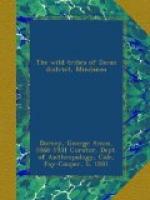[1] The religious head of the settlement.
SOCIAL ORGANIZATION
The before-mentioned ballyan direct the religious observances of the tribe. Their mysterious powers give them great influence among their fellows but, nevertheless, they are subservient to the local ruler.
The tribe is divided into many small groups, each of which is governed by a bagani. To reach this coveted position a man must have distinguished himself as a warrior and have killed at least ten persons with his own hand.[1] The victims need not be killed in warfare and may be of any sex or age so long as they come from a hostile village. When the required number of lives has been taken, the aspirant appeals to the neighboring bagani for the right to be numbered in their select company. They will assemble to partake of a feast prepared by the candidate and then solemnly discuss the merits of his case. The petition may be disregarded entirely, or it may be decided that the exploits related are sufficient only to allow the warrior to be known as a half bagani. In this case he may wear trousers of red cloth, but if he is granted the full title he is permitted to don a blood-red suit and to wear a turban of the same hue. This distinction is eagerly sought by the more vigorous men of the tribe and, as a result, many lives are taken each year.
[1] At Mayo it was said that it is necessary to kill only six, but the two bagani living there had each killed more than twice that number. Among the Mansaka the number required is often as high as thirty.
A short time ago a candidate entered the district of Bungalung on the east coast of Davao and killed thirty-two persons. In that same section are now living five bagani who have gained this title by similar exploits.[2] Whole communities become involved in feuds as a result of these individual raids, for it is the duty of a murdered man’s family to seek revenge for his death. It is not necessary that they kill the offender, as any member of his family or settlement will suffice. In some districts the unmarried relatives of a murdered person are not allowed to wed until the death is avenged.




